
SARKAN race
(from Reality-691)
Classification: Alternate timeline (Reality-691) extraterrestrial humanoids
Location/Base of Operations: Sarka, third planet from the sun in the Tilnast star system in the Milky Way galaxy
Habitat: Semi-temperate, 74% covered by water
Gravity: 110% Earth
Atmosphere: 73% nitrogen, 22% oxygen
Known Members: battle cruiser captain,
Carinthus,
Grand Inquisitor's aide,
Infonet newscasters,
local newscaster, Wileaydus (aka Spirit of Vengeance)
Estimated population: Unrevealed (population in Reality-616 during early 21st century was stated to have been 4.3 billion)
Affiliations: The Universal Church of Truth (including the now-deceased Judan Grand Inquisitor)
Enemies: The Spirit of Vengeance (Wileaydus); Guardians of the Galaxy (Major Vance Astro, Captain Charlie-27, Martinex T'Naga, Nicholette "Nikki" Gold, Yondu Udonta, Starhawk/Stakar Ogord, Aleta Ogord), all non-believers/heretics
First Appearance: Guardians of the Galaxy I#12 (May, 1991)
(in mainstream reality) Strange Tales I#179 (April, 1975)
Powers/Abilities: None. Any individual Sarkans who possessed superhuman abilities gained them from external sources.
However, since their species evolved on a planet whose surface gravity was 10% stronger than that of Earth, it's possible that an average Sarkan may have been at least slightly stronger than an average human from Earth. So far, such strength has not been documented.
Type: Humanoid
Eyes: Two (black)
Fingers: Four (plus opposable thumb)
Toes: Five
Skin color: Light blue (except for black markings around their eyes and along their noses)
Hair: Black
Average height: 6'1"
Other Distinguishing Features: Most Sarkans have pointed ears, but some do have ears that are rounded.
All Sarkans have black markings around their eyes and along their noses, but whether these markings are natural (like the black fur that forms a raccoon's facial mask) or artificial (like tattoos that have cultural significance) in nature has never been revealed.
Many (but not all) Sarkans have three (flesh-covered) ridges of bone on their skulls, ridges that run from front to back (longitudinally?) across the tops of their skulls. On some Sarkans, those bone ridges extend back far enough that they join together at a point on the backs of their heads. However, some Sarkans appear to have only a single central ridge while others seem to have no ridges at all.
Type of government: Theocratic monarchies. By the year 3018 A.D., Sarka was part of the interstellar religious empire known as the Universal Church of Truth, and was ruled by a Grand Inquisitor, an official who had been chosen to rule the planet on behalf of the UCT.
Cultural Traits: Militaristic, fanatically religious
Level of technology: Moderately advanced starships with warp-drive
History:
(Official Handbook of the Marvel Universe I#9: Alien Races: Sarks entry) - Sarka was the
third planet from the sun in the Tilnast star system of the Milky Way galaxy.
(Guardians of the Galaxy I#14 (fb) - BTS) - At some time before (or during) the early 31st century, Sarkan architecture (at least in the capital city) began to resemble that of Earth (especially the United States of America) in the 20th century.
(Guardians of the Galaxy I#13 (fb) - BTS) <Sometime well before the year 3018 A.D.> - The people of the planet Sarka in the Tilnast star system were contacted by the Universal Church of Truth, an interplanetary theocratic monarchy. Although the Sarkans had their own religion(s) and were "fanatically religious" by nature, for some reason the majority agreed to convert to the Universal Church. Subsequently, any pre-existing religions were outlawed.
(Guardians of the Galaxy I#14 (fb) - BTS) - With the Sarkan people accepting the Universal Church and following it willingly, the Church's standard operating procedure began to be applied. All non-believers were, when found, taken to the Indoctrination Chamber where they were tortured (to "purify their souls") until they either converted to the Church or died from their injuries. Those non-believers who refused to surrender to the Church's authority were considered "infidels" who were to be summarily executed by the Black Knights.
(Guardians of the Galaxy I#12-14 (fb) - BTS) - As a symbol of their faith, the people
of Sarka all began wearing "ankh" pendants to show that they were True-Believers in the Universal
Church of Truth. Those (few?) Sarkans who did not believe in the UCT wore the pendants in order to
hide from those who would persecute/torture/execute them.
The UCT's "ankh" symbol was also widely displayed on buildings.
(Guardians of the Galaxy I#51 (fb) - BTS) - At some point, the intergalactic news source known as Infonet began broadcasting from the planet Sarka.(see comments)
(Guardians of the Galaxy I#14 (fb) - BTS) - One of the Universal Church's Grand Inquisitors, a member of the Judan race, became the highest authority on Sarka.
(Guardians of the Galaxy I#13 (fb) - BTS/Guardians of the Galaxy I#50/2 (fb) - BTS) - At some point, Wileaydus, the last priest of an outlawed faith, discovered how to use the supernatural Fires of Kauri (Hades) to transform into a flaming skeletal being. Calling himself the Spirit of Vengeance, he began a savage and violent mission of retribution against the Universal Church of Truth.
(Guardians of the Galaxy I#12 (fb) - BTS) - Over an unspecified time period, the Spirit of Vengeance killed 42 of the Universal Church's Black Knights of Truth who had been stationed on Sarka. The Universalites regarded these murders as the work of a serial killer whom they dubbed the "Flaming Demon."
(Guardians of the Galaxy I#15 (fb) - BTS) <3018 A.D.> - The demon lord Mephisto arranged for the Stark to attack Firelord in the Tilnast system. Unknown to those involved, the sole purpose for that attack was to lure the Guardians of the Galaxy to that location.
(Guardians of the Galaxy I#12 (fb) - BTS) - One night, the Spirit of Vengeance killed
two more Black Knights. Their bodies were discovered the following morning.
Later that day, astronomers on Sarka discovered that at least one alien starship
(a Stark mother-ship and/or the Captain America II) was in the vicinity of their system's
asteroid belt.
(Guardians of the Galaxy I#11) - In the star system where the planet Haven had just been consumed by the reborn Phoenix, the Guardians of the Galaxy received a priority one distress signal from Firelord.
(Guardians of the Galaxy I#12) - In the Tilnast system's asteroid belt, the Stark cyborg warrior Overkill battled Firelord. The Protector of the Universe was surprised to find himself being overpowered by his attacker and wondered if he had doomed the Guardians of the Galaxy (by calling them for help).
(Guardians of the Galaxy I#15 (fb) - BTS) - After the Guardians had arrived, the demon lord Mephisto subtly alerted the Spirit of Vengeance to their presence. Mephisto also imperceptibly augmented the Spirit's minor demonic power with his own so that the Spirit's attack would rob Starhawk/Stakar (as the One-Who-Knows) of both his awesome powers and his vaunted memories.
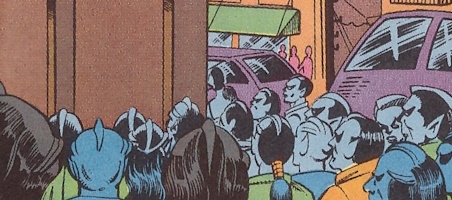
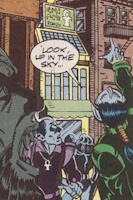
(Guardians of the Galaxy I#12 (fb) - BTS) - Astronomers on Sarka observed an unusually large solar flare (caused when Starhawk took Firelord into that star in order to re-energize him).
(Guardians of the Galaxy I#12) - As most residents of Sarka went about their normal daily
routines, a female newscaster revealed that astronomers had reported that an unusually large solar flare
had erupted "seconds ago." She also reported that the astronomers had confirmed earlier reports that at
least one alien starship was in the vicinity of the asteroid belt. She ended her newscast by reporting
that two more Black Knights had been found murdered that morning and that police suspected that they had
been killed by the same serial killer who had previously killed 42 of the Sarkans' planetary protectors,
the Flaming Demon. Among the Sarkans who watched that newscast on a large TV screen provided for public
viewing were Carinthus and Wileaydus. When Carinthus wondered aloud who would condemn their soul with
such blasphemy, Wileaydus replied that only a madman or a demon would do so, then excused himself to
return to his work.
Later, Wileaydus was able to use technology to observe what was happening in the
asteroid belt (a battle between the Guardians of the Galaxy and the Stark cyborg warrior Overkill).
Coming to the mistaken conclusion that the Church was sending super-powered Knights to Sarka, he thought
to himself that even they would know what it meant to face the righteous fury of the Spirit of
Vengeance!
(Guardians of the Galaxy I#13) - Some time later, still sure that the starship must be Black Knight reinforcements, Wileaydus transformed into the Spirit of Vengeance, used the Fires of Kauri to create his Death-Cycle, and flew off into space to confront those he believed were heretics. His departure from the roof of a building in the city was witnessed by some pedestrians who saw him flying up in the sky.
(Guardians of the Galaxy I#13/Guardians of the Galaxy I#15 (fb) - BTS) - When the Spirit of Vengeance approached the Captain America II in the asteroid belt, Starhawk went out to meet the Spirit and try to convince him that those aboard the starship were not who he thought they were. However, sure that he was right and unwilling to even listen to any lies, the Spirit attacked first and used the flaming tusks of his Death-Cycle to impale and severely injure Starhawk, with the (Mephisto-augmented) hellfire robbing him of his memory and making him no longer the One-Who-Knows. However, Aleta was able to convince the Spirit that they were not members of the Church, and the Spirit agreed to go to their starship so they could show him.
(Guardians of the Galaxy I#13 (fb) - BTS) - Meanwhile, Nikki made radio contact with someone on Sarka and asked if the Guardians could make repairs to their starship there. When the person on the planet asked if they were "Universalites" and Nikki asked what that meant, they briefly cut off communication, but then called her back and stated that the starship could land but only if they killed the Spirit of Vengeance who was then nearing the Captain America II.
(Guardians of the Galaxy I#14) - As most residents of Sarka continued to go about their normal daily routines, the UCT Holy Fleet surrounded the alien starship and demanded that they surrender the flaming demon at once or be obliterated. Hearing this convinced the Spirit, who had been battling the Guardians since Replica had revealed herself to be a Universalite, that the Guardians had been telling the truth about not being his enemy. To atone for his transgression, the Spirit flew away from the starship and through the fleet in an attempt to buy the Guardians enough time to escape that sector of space. However, the Holy Fleet then informed them that the penalty for harboring a heretic was death and that they would be executed in thirty seconds. Since their starship would have been unable to escape before the fleet opened fire, Martinex had Replica speak with the fleet's commander, the Grand Inquisitor, and she was able to convince him that the Guardians had been attacked by the demon. The Grand Inquisitor noted Replica's reverence, rescinded the death sentence and escorted the Guardians to Sarka where their starship was put in dry dock in orbit around the planet to be repaired by a team of Universalites and Sarkans.
(Guardians of the Galaxy I#14) - On Sarka, most Sarkans remained unaware of the presence of the "heathens" in the palace of the Grand Inquisitor, of the battle that began once he had ordered them to be taken to the Indoctrination Chamber and of how Vance Astro and Yondu had escaped to search for help, using the robes of fallen Universalites to disguise themselves. Once Martinex, Nikki and Charlie-27 had all been defeated and had been sent to be indoctrinated, a Sarkan aide approached the Grand Inquisitor and showed him the stars that had been found on the chests of the fallen heathens. To keep the Universalites from using them to find Vance and Yondu, Replica did not reveal that the stars were communicators and instead committed a mortal sin by lying and claiming that she believed they were purely ornamental.
Meanwhile, still disguised as robed pilgrims, Astro and Yondu explored the city and decided to spend some time in a downtown neighborhood bar talking to the customers in order to learn if the people of Sarka were truly enslaved by the Church.
In the asteroid belt, Aleta found and rescued the nearly-transparent Starhawk. In the process, he was able to let her see a memory about Malevolence and the Child.
Replica secretly visited the Indoctrination Chamber where she found that Martinex was the only one of the three Guardians who was still conscious after the torture which had been inflicted upon them. Replica tried to convince him that the Church was only trying to purify their souls and suggested that they could convert. Martinex instead asked her to bring them their stars. Replica continued to try to get Martinex to join the UCT but, once he stated that he could never worship a deity capable of inflicting such pain in the name of love, Replica said that she couldn't help them and ran out of the room sobbing.
Back at the bar, Astro and Yondu had determined from their conversations (about local politics and televised sports) with the patrons that the Church was everywhere, that their entire culture revolved around it, and that the Church was a positive force in their lives, one from which they drew their strength. Soon after exiting the bar, Astro and Yondu witnessed two fleeing (non-Sarkan) "infidels" being blasted and killed by two (non-Sarkan) Black Knights who were then killed by flame blasts from the Spirit of Vengeance. When the Spirit asked the pilgrims if they wished to die as well, Astro and Yondu revealed themselves and asked for his help. Once they were all flying through the city aboard the Death-Cycle, Yondu or Astro engaged in an unproductive discussion about religion with the Spirit, one that ended once they revealed that their friends had been captured and the Spirit immediately changed course to take them to the Indoctrination Chamber so they could see the "true evil" of the Church for themselves.
(Guardians of the Galaxy I#14 (fb) - BTS) - In orbit, Aleta and Starhawk boarded the Captain America II and retook control of the starship by teleporting all the Universalites and Sarkans off ship before they even knew that the two Guardians were there.
(Guardians of the Galaxy I#14) - Back in the Indoctrination Chamber on Sarka, Replica (disguised as the Grand Inquisitor) entered and told the Universalite on duty that the prisoners were to be released because their souls had been saved. However, seconds after they were freed from their bonds, the real Grand Inquisitor arrived and demanded to know who dared to impersonate their royal personage. Replica shifted back into her human form and tossed the three communications stars to the Guardians. When she mentioned that she wasn't going to leave with them, Martinex disagreed, grabbed her arm and teleported her away with him just as the Death-Cycle and its passengers burst in through one of the chamber's walls. Seeing that Nikki and Charlie-27 were even then beaming out, Astro and Yondu did the same, leaving the Spirit of Vengeance there to do his work and enact his vengeance on the Grand Inquisitor.
(Guardians of the Galaxy Annual I#2 (fb) - BTS) - The Spirit of Vengeance removed one of the Guardians of the Galaxy's stars from the corpse of the Grand Inquisitor.
(Guardians of the Galaxy I#51 (fb)) <3019 A.D.> - Presumably aboard their new starcruiser, the Icarus, the Guardians watched an Infonet broadcast during which a female Sarkan newscaster reported that the Constabulary had arrested Charlie-27, the last known survivor of Jupiter, who had been accused of being Ripjak, the interplanetary serial killer. According to what informed sources had told Infonet, there was solid evidence against the Jovian who was currently incarcerated on the maximum security prison planet Stockade.
(Guardians of the Galaxy I#51 - BTS) - After traveling to Earth, the Guardians teleported down into the village (in what had once been Latveria) where Molly Fitzgerald (Shamrock) and Cuchulain were now living. After a brief battle caused by a misunderstanding, Vance Astro explained how they had recently become separated from Charlie-27 and, although they had since become aware of his location, they had come to Earth to recruit Shamrock and Cuchulain because they were going to need "serious muscle" in order to liberate Charlie-27. Nikki then explained that they had found out Charlie-27's whereabouts like everyone else -- "by watching an Infonet broadcast from the planet Sarka!" Shamrock chose to stay on Earth to care for the children in the village but Cuchulain agreed to join the Guardians on their mission to free their teammate from Stockade.
(Guardians of the Galaxy I#56) - Aboard the Icarus, Charlie-27, Nikki and Talon watched a special bulletin from Infonet in which a male Sarkan newscaster reported that Infonet's telecameras had confirmed the depopulation of the planet Aran IV. After stating that this reprehensible genocidal act was unquestionably the work of the infamous Ripjak, who had been reported to have been in custody on the prison planet Stockade, the newscaster began a brief interview with the Chief of the Constabulary who was also the head of operations on Stockade. When the newscaster asked him to confirm reports that the last surviving Jovian, Captain-27, was no longer their prime suspect and had been released, the Chief had no comment, except to say that if anyone wanted information on Ripjak, they should contact Captain-27's associates, the Guardians of the Galaxy. The Guardians were extremely upset that the corrupt warden was falsely implicating them in front of trillions of Infonet viewers.
Thousands of parsecs away, Ripjak had also been watching that Infonet broadcast. However, after the Sarkan newscaster spoke of how galactic residents continued to live in fear of "the malignant mass murderer, Ripjak," the Martian ordered his starship's computer to switch off the audio portion of the broadcast. Ripjak then spoke aloud about the ignorant fools and how their perception of his true objective was absurdly skewed!
Comments: Autolycus created by Jim Starlin
Sark race created/named by the staff of the original Official Handbook of the Marvel
Universe (led by Head Writer Mark Gruenwald).
Sarkans from Reality-691 created by Jim Valentino.
Signs written in what was presumably meant to be the Sarkan language appear in Guardians of the Galaxy I#12-14, in the backgrounds of scenes set on Sarka. The symbols reminded me of the letters used in Interlac, the fictional language created for use in stories featuring the Legion of Super-Heroes. However, when I compared them, they turned out to not be that similar after all.
This profile's main image is of a male member of the Sark race, taken from that race's entry in The Official Handbook of the Marvel Universe I#9. I used it in this profile because: A) there is no official image of the Sarkan race; and B) I also couldn't find a suitable full-body image of a Sarkan. So, since the people from the planet Sarka would have looked like Sarks if Jim Valentino hadn't chosen to tweak their appearance, I decided to go with the official Sark image instead. Also, since some Sarkans don't have cranial ridges, this image is a close enough match to their appearance.
Sarks vs. Sarkans
According to the Official Handbooks of the Marvel Universe, "Sarks" is
the name of the blue-skinned humanoid race who evolved on Sarka, the third planet from the sun in the
Tilnast star system of the Milky Way galaxy. However, this name has so far only appeared in Official
Handbook profiles and never in any of the few stories set in the mainstream MU that feature members of
this race.
In comparison, their counterparts from the 31st century future of Reality-691 don't fare much better. During the three issues of the first Guardians of Galaxy series that featured the race of blue-skinned humanoids native to the planet Sarka that existed in that timeline, the name of that race was mentioned only once, when one of the Guardians asked Aleta why there were no "Sarkans" on board the Captain America II. To make matters worse, issues of the later Galactic Guardians miniseries consistently (and mistakenly) refer to this race as "Sakrans" from the planet "Sakra" instead. Ooops.
In the end, I decided to use the "Sarkan" name over the official "Sark" name simply because there is at least some evidence that that is the name by which this species is actually known, at least in Reality-691. Of course, future stories may prove my choice to have been incorrect.
Additionally, the Sarks from Reality-616 and the Sarkans from Reality-691 also differ physiologically in several ways related to their heads. First, the images of the Sarks from the Official Handbooks show them as having very little hair on their heads. However, this is not fully accurate. While the upper halves of the heads of Autolycus and Levan were bald except for narrow strips of hair that ran along the center of their crowns, Levan was also bald elsewhere except for two strips above his ears while Autolycus had thick hair on the sides (enough to cover his ears) and the back of his head. In contrast, although they all had high hairlines, most Sarkans were depicted as having hair covering a lot more of their heads. Of course, since the only two "Sarks" who have ever been seen were male, it could just be that those two were experiencing the Sark version of male-pattern hair loss.
The second difference is more significant. Unlike both Autolycus and Levan, most (but not all) Sarkans had three flesh-covered ridges of bone on their heads, all running from back to front, with one at the top of the skull and the other two to each side, about halfway between the top ridge and the ears. The fact that these ridges were innate is shown by their presence on the Spirit of Vengeance's flaming (but fleshless) skull. However, it should be noted that some Sarkans were depicted with only a single central ridge and there were also some Sarkans who had none.
The presence (or absence) of these skeletal ridges could indicate that the evolutionary pathway followed by the Sarkans differed slightly from that taken by the Sarks. Alternatively, it could be that these ridges are a feature that developed only in a sub-group of the larger Sark/Sarkan populations, and that some (or many) Sarks actually do have these ridges while many (or some) Sarkans also do not have them. The fact that the UCT captain that Malevolence ordered to pursue and destroy the starship being piloted by Replica and the male Infonet newscaster who reported on the depopulation of Aran IV both appeared to be Sarkans but lacked these ridges would seem to support the latter possibility, but more data would be needed before a definitive conclusion could be reached.
It should be noted that these ridges don't appear in any of the images of the Sarks that have (so far) been published in any of the Official Handbooks. This omission could be proof that no Sarks from Reality-616 have such ridges.
Finally, while all but one (or maybe two) of the Sarkans seen in Guardians of the Galaxy had pointed ears and Autolycus had ears whose shape cannot be determined because they were always completely covered by his hair, Levan's ears were as rounded as those of (most) humans. It's also worth noting that Levan lacked the black facial markings seen on Autolycus and all of the Sarkans. Some thoughts as to what this might mean can be found in the Comments section of Levan's profile.
Sark race in Reality-616
The Sarks have quarter-page entries in the first and second volumes of
The Official Handbook of the Marvel Universe. These profiles provide data about the Sark race that
existed in Reality-616 during the early 21st century so some of the information may not be
applicable to the "Sarkan" race who existed in Reality-691 during the early 31st century.
The estimated population of 4.3 billion is especially suspect.
So far, the only two members of the Sark race who have been encountered
by beings from Reality-616 are Autolycus and Levan. Some (unidentified) Sarks may have appeared in alien crowd
scenes, but I don't recall seeing any. Here's a chronological list of those issues which provide significant
information about the Sarks:
It should be noted that the Official Handbook's claims that General Egeus from Warlock I#9 (October, 1975) was also a Sark would seem to be incorrect. Although Egeus, like Autolycus, was a Black Knight, his facial features and red skin were not Sark-like (Sarkoid?) at all.
It should also be noted that Autolycus was not exactly from Reality-616. Instead, he (and all of the other beings whose souls were contained within Warlock's Soul Gem) originated in the timeline that became Reality-616 after the timequake caused when Warlock prevented his future self from becoming the Magus. Unfortunately, I'm not exactly sure how that pre-timequake reality relates to what is now the "mainstream" Reality-616. Gamora is said to have originated in Reality-7528 but that was an alternate future of the pre-timequake mainstream reality and may not have been exactly the same as the pre-timequake reality. There's also the "Magus future" timeline, a timestream that was made detached and redundant by the timequake. It had effectively ceased to exist until Warlock was forced to (retroactively) graft it onto Reality-616 to prevent the Fault from spreading until it obliterated everything.
According to the quarter-page entry on the Sarks that was presented in The Official Handbook of the Marvel Universe II#15, "Sarks were among the highest officials in the Universal Church of Truth." However, since that handbook was published before the GOTG series began, this information presumably pertains only to the Magus-led UCT that existed in Reality-616 before the timequake caused by Adam Warlock retroactively erased that UCT from history.
The name of the Spirit of Vengeance's mortal form
In Guardians of the Galaxy I#12 (May, 1991), the male Sarkan soon to
be revealed as being the Spirit of Vengeance is identified in-story as "Wileaydus" twice: first on
page 16, when his friend Carinthus addressed him by that name, and again on page 19, when the
Omniscient Narrative refers to him by that name. So far, so good.
Unfortunately, in Guardians of the Galaxy I#13 (June, 1991), the Omniscient Narrative's description of the Spirit of Vengeance's mortal form on page 9 states, "His name is Autolycus. He is the last priest of an outlawed faith." So, now we had a single character being called by two different names. Oops.
In his next six appearances, beginning with GOTG I#14, any questions about what the Spirit's mortal form's name was went unanswered because the character appeared only in his supernatural/demonic form. In fact, the only time that his mortal identity was even mentioned was in a letter printed in the "Readers' Space" page of GOTG I#16 in which a reader pointed out that Wileaydus had been incorrectly dubbed "Autolycus" in GOTG I#13.
However, when it was decided that the Spirit of Vengeance would receive an Official Handbook of the Marvel Universe: Master Edition page, the handbook staff took the opportunity to correct this mistake and, by using the "Robert Bruce Banner" solution, they declared that the real name of the Spirit's mortal form was actually "Wileaydus Autolycus."
I am, in a word, unimpressed by this choice.
It is an unfortunate fact that writers, like all humans, are imperfect beings who can make mistakes when writing their stories. Similarly, editors can also make mistakes by not catching and correcting mistakes in the stories that they edit before sending them to the printers. And those mistakes can sometimes involve the names of characters in those stories. For example, one of the first profiles I ever wrote was about a character who, in the space of the single story in which he appeared, called his wife by two different names. In that case, short of revealing that the wife was suffering from Dissociative Identity Disorder and the husband was somehow able to recognize which personality was in control of her body at any given time, applying the "Robert Bruce Banner" solution was probably the best way to correct this blatant error.
Having said that, I don't believe that ALL such mistakes should ALWAYS be corrected. After all, despite the presence of mutants and magic and aliens and super-heroes, the Marvel Universe is supposed to be like the real world. Therefore, since real people do sometimes call other real people by the wrong names, it only makes sense that such mistakes would also happen in the Marvel Universe, and sometimes no further explanation is (or should be) required. For example, one of the characters who exists on Earth-616 is Doctor Jeffrey Steven Christiansen, a doctor of veterinary medicine. Suppose that some writer wanted to use this character but, for some reason, possibly a mistake made by the letterer, he was referred to as "Dr. Joffrey Christiansen" at one point in the story. Should the Official Handbook automatically declare that this character's real name was Dr. Jeffrey Joffrey Christiansen? Or should the context in which the wrong name was used be taken into consideration? On the one hand, if the person who used the wrong name was a casual acquaintance and was in a distracted state of mind, as well as being a Game of Thrones fan, then the mistake could (and should) be dismissed as a simple slip of the tongue. On the other hand, if the person who used the wrong name was someone who was really close to him, like the doctor's wife or one of his brothers, then that would perhaps merit a stronger explanation, like maybe the wife or the brother had actually been secretly replaced by a Skrull impersonator.
The question of context is especially important when these mistakes occur in Omniscient Narratives, as this one did. Omniscient Narratives are odd in that they can be somewhat schizophrenic in nature. On the one hand, such narratives are a way by which writers can convey information to the readers without having to use images or dialogue. In theory, since the data is coming directly from the writer, it should be considered to be absolutely and irrefutably accurate...but this is not always true. Sometimes, as in this case, the writer misremembers something from a previous work. Other times, the writer is not totally obsessed with continuity and thus might overlook a fact that was only ever mentioned once in a single comic that not many people have ever read. And sometimes the facts that are presented in the Omniscient Narrative were accurate at the time of writing/publication but have since retroactively been made into mistakes by retcons.
On the other hand, although Omniscient Narratives do supposedly know
everything about the characters and events in the stories in which they are used, they also exist outside
of the stories themselves. As a result, this means that mistakes made in these narratives are, in a way,
less relevant to the stories and thus can be more easily ignored than mistakes that appear in images or
dialogue, and without really causing any damage to the stories. Here are a few examples of mistakes made
in Omniscient Narratives that have never been corrected and (probably) never should be:
In conclusion, I hope that this explains why I strongly dislike the Official Handbook's idea that the name of the Spirit of Vengeance's mortal form is "Wileaydus Autolycus." The mistake was a minor one that had zero effect on the story and the correction requires the assumption that members of the Sarkan race identify themselves using personal names that consist of (at least) two names, presumably a given name and a family name, even though all other Sarks/Sarkans have only ever been shown using a single name. Although the sample size of named Sarkans is, admittedly, quite small, being made up of only four characters, I don't feel that that is enough to justify changing things without any in-story evidence that is should be changed.
Thinking about this situation reminded me of a saying about when a difference wasn't a difference. I looked up the exact quote online and it turned out to be, "A difference which makes no difference is no difference at all." However, during that search, I came across another quote that might be even more applicable, "Be indifferent to what makes no difference." In my opinion, a logical paraphrasing of this statement would be, "A mistake which has no effect should not require a retcon to correct it." That quite concisely explains how I feel about the retconned name.
On a related topic, the following table summarizes how four Sark-related names are used and (mis)spelled in the eight comics in which they have appeared to date.
Issue
Star system
Planet
Race
the Spirit's mortal identity
GOTG I#12
Tilnast (dialogue)
Sarka (ON x 2)
n/a
Wileaydus (dialogue + ON)
GOTG I#13
Tilnast (ON)
Sarka (ON)
n/a
Autolycus (ON)
GOTG I#14
Tilnost (ON)
Sarka (ON x 3 + dialogue)
Sarkans (dialogue)
n/a
GOTG I#15
Tilnast (dialogue)
Sarkas (Nikki x 2)
n/a
n/a
GOTG I#50/2
n/a
Sakra (Uilig)
n/a
Wileyadus (Uilig)
GOTG I#51
n/a
Sakra (Nikki)
n/a
n/a
Galactic Guardians#3
n/a
Sakra (dialogue x 2)
Sakran; Sakrans (dialogue x 2)
Wileyadus (dialogue)
Galactic Guardians#4
n/a
Sakra (Mainframe)
n/a
Wileyadus (dialogue + footnote)
Accuracy
3/4
7/14
1/3
2/7
To summarize, over the course of the only eight issues in which any of them appear, these four names are used a total of 28 times. And out of those 28 usages, the completely wrong name (Autolycus) is used once while correct names are misspelled fourteen times.
To break it down further, Jim Valentino made four of those mistakes (out of seventeen usages) while Michael Gallagher misspelled all ten of his usages and Craig Anderson made the final mistake in a footnote. Of course, since Mr. Anderson was the editor for all eight of those issues and he didn't catch/correct any of those mistakes, he would technically be responsible for all of them.
Having said that, I feel that I should mention that Mr. Valentino, in a Guardians of the Galaxy Retrospective posting that he made on ImageComics.com back in 2005, stated that the "Sarkan" who was the Spirit of Vengeance's mortal form "was inspired by the character, Autoclycus, from Jim Starlin's Warlock saga (he is even mistakenly referred to as Autoclycus in one panel this issue)." However, Mr. Valentino did misspell that character's name by twice referring to him as "Wilyeadus." As you can see, he also twice mispelled "Autolycus" as "Autoclycus."
For what it's worth, I can only presume that "Wileaydus" and "Wileyadus" and "Wilyeadus" all at least sound alike, right? In that retrospective that he posted on the Image board, Jim Valentino did claim that that name was a play on the phonetic pronunciation of "Will-He-Aid-Us."
Sarkan religion(s)
When Jim Starlin created Captain Autolycus, he didn't provide the character
with much of a background beyond being a trained warrior who loyally followed the orders he was given by
his superiors in his faith even when he was fully aware that they were not just. The staff of the original
Official Handbook took those basic facts and used them to create the Sarks, a race whose cultural traits
made them militaristic and fanatically religious, and who were governed by theocratic monarchies. And since
the only other Sark to be seen in Reality-616, Levan, was a mercenary who appeared to have no real connection
to his homeworld, exactly what the civilization on the planet Sarka was really like remained something of
a mystery.
And then Jim Valentino decided to use that race in his Guardians of the Galaxy series and thus the Sarkans were born. Sadly, aside from the fact that Wileaydus was the last priest of an outlawed faith, we never got to learn much about their religious beliefs. After some BTS conversations with patrons of a local bar, Astro and Yondu came to the conclusion that the Spirit of Vengeance's claims that his world had been conquered and enslaved by the Universal Church of Truth were false because the people had willingly chosen to follow the church and that it was a positive force in their lives, something from which they drew their strength and around which their entire culture revolved. Furthermore, while Astro accepted the fact that the UCT was undeniably evil, the only Sarkan who was described (by Yondu) as a fanatic was the Spirit who engaged in several rants about how the unholy doctrine of the UCT had corrupted the minds of the innocent and turned them away from the One True Faith, and how they had cloaked their atrocities behind a false divinity.
Since no detailed information about the religious history of the Sarkans was revealed in those few GOTG issues that were set on Sarka, we are forced to rely on the OHotMU's claim that the planet was governed by theocratic monarchies. Unfortunately, that statement is less than definitive since it can be interpreted in one of two ways. On the one hand, if those monarchies existed sequentially, then that would mean that Sarka had been governed by a series of worldwide monarchies, each of which had ruled the entire planet for a time before being replaced by a subsequent monarchy that may have been based on a different religion. On the other hand, if those monarchies existed concurrently and were based on different religions or even different sects of the same religion, then that could mean that the various territories ruled by those monarchies were often (if not always) mutually antagonistic to each other, given that each monarchy would have considered themselves to be the One True Faith and all others to be heretics and blasphemers. This could have meant that Sarka had a history of religious tension or even holy wars between its various countries. However, we weren't given enough information to determine which scenario is correct. Even the statements made by the Spirit about how the UCT had turned the people of Sarka away from the One True Faith are not conclusive proof because the (unidentified) outlawed faith of which Wileaydus was the last priest was never stipulated as having been the only religion on Sarka before it was replaced by the Universal Church of Truth.
Given that the UCT is clearly shown to be an objectively and monstrously evil theocratic empire that routinely commits genocide against entire planetary populations if they refuse to convert to their faith and whose followers seem to have no problem with the idea of non-believers being tortured or killed solely because they weren't believers, I felt that Astro and Yondu were presented as being almost tolerant of them. While I agree with Astro's position that the Guardians had no right to force their views on people who were willing followers of the UCT, I did find it odd when he attempted to convince the Spirit that he, by killing Black Knights who killed people for the crime of not believing in the UCT, was somehow just as wrong as the knights were. As for Yondu, his denunciation of the Spirit as a fanatic in GOTG I#14 is perhaps foreshadowing of the revelation in issue #16 that he, as a Centaurian warrior holy man, had been taught that any Centaurians who did not follow their people's holy path and worship the god Anthos were considered to be without faith and must die (i.e., be killed). It was oddly unsettling to read that issue and discover that Yondu, who had always been presented being a good character, was also a devoted follower of a religion that was lethally intolerant of non-believers within Centaurian society.
The Universal Church of Truth that exists in Reality-691
This timeline's version of the UCT was clearly inspired by and based on
the Universal Church of Truth that had existed in
Reality-616 until Adam Warlock retroactively altered history in order to make it so that neither it nor its
founder, the Magus, had ever existed in that
timeline. While it at first appeared that this UCT might have been just a divergent version of that
original UCT, it was soon revealed that, despite their very strong similarities, there were significant
differences between the two theocratic galactic empires. Perhaps the biggest difference was that the 691
Church had somehow come into being as a sect that worshipped a deity known as the Magus even though, unlike
what happened in the pre-timequake Reality-616, no such entity actually existed in their timeline. Sadly,
no explanation for how the Magus had come to be worshipped was ever provided.
Another major way in which the two versions of the UCT differed was in their later histories. For one one thing, the Church in Reality-616 had Sarks (like Autolycus) as members and had conquered and enslaved a race of green-skinned armless bipeds by the early 21st century. In contrast, although the Church in Reality-691 had converted the people of Sarka and committed genocide against that armless race before the year 3018 A.D., those events had occurred so recently that a last priest of an outlawed faith was still alive on Sarka and the rotting corpses of that genocided race were not old enough to have decomposed into skeletons. This indicates that the 691 Church hadn't taken control of Sarka's sector of space until about a millennium after the 616 Church had done so in its timeline, and implies that the 691 Church, lacking the direct leadership of their god, had not expanded across their universe as quickly as the 616 Church had.
Another possible difference in their chronologies concerns exactly when the Church was founded. In (pre-timequake) Reality-616, the Magus founded the UCT after he conquered the planet Sirus X sometime before the year 3000 B.C. In contrast, Interface told Martinex that the 691 UCT had searched space for their god for an unspecified number of centuries without success, and that it was only then, "over a thousand generations ago," that they had begun trying to create their god in their own image. Even if one assumes that a generation was only 20 years long, that would still place the founding of the 691 UCT sometime before 17,000 B.C. However, in that Guardians of the Galaxy Retrospective that he posted on his Image board back in 2005, Jim Valentino revealed that, if he had continued on the title after issue #51, he had been planning to introduce the Her of that timeline and reveal that she was the actual biological mother of the Protege. This would have established that the origin of the Protege that was revealed by Interface in issue #16 was just a false story that the Church had made up about the child-god's origin. Of course, Mr. Valentino was removed from the title before he could write that story but, if that idea were still somehow valid, that could indicate that the 691 UCT may have been founded much more recently than that story had implied.
All in all, I would have preferred it if we readers had been told more about when Sarka was converted by the UCT Specifically, I would really have liked to have been told how Wileaydus became the "last priest of an outlawed faith." Was it because he had already been a priest when the Church converted his people and he was the only priest who had (somehow) managed to keep his religious beliefs a secret from the new alien overlords? Or was it because he was the last surviving member of a religion whose members had been forced to practice their true faith in secret after it had been outlawed by the UCT years or even generations before Wileaydus was even born? As it stands, either possibility could be correct and I find that ambiguity to be frustrating.
DIVERGENCE POINT!?!
The future in which the Guardians of the Galaxy existed initially had no
apparent connection to the "mainstream" Marvel Universe. Then, after that connection had been established
(by Steve Gerber) in the pages of Marvel Two-In-One I#4-5 and Defenders I#26-29, that timeline (later called
Earth-691) was considered to be a possible alternate future of the "mainstream" MU (now called Earth-616).
This meant that Earth-691 was something that the present-day Earth-616 could potentially become.
That situation changed in Marvel Two-In-One I#69 when Major Vance Astro caused the latent mutant psycho-kinetic powers of his younger self, the teenaged Vance Astrovik, to be activated centuries before his own powers had manifested during his thousand-year spaceflight. This story seemingly established what the divergence point between the two timelines was, and meant that Earth-616 could no longer become Earth-691. As a result, many issues of the first GOTG series contained editorial footnotes reminding readers that the GOTG timeline had diverged from the mainstream Marvel Universe in that MTIO issue. However, some GOTG fans believed that the two timelines must have actually diverged at some earlier point and cited the fact that a first Martian invasion in 1901 A.D. had been established as having taken place on Earth-691 while no such invasion had occurred on Earth-616. Other fans argued that the fact that the Hawk God had been sent back in time to Arcturus IV where he had stood, trapped as a statue, for "centuries" before Stakar and Aleta had released him in the early 21st century, meant that, according to the rules of time travel established by Mark Gruenwald, his having traveled back in time had caused the divergence point to be pushed back to the early 19th century, if not earlier.
However, it's only now, as I am completing this profile, that I realize the truth: After Adam Warlock caused the timequake that retroactively altered the 616 timeline and erased both the Magus and his Universal Church of Truth from history, the Universal Church of Truth that existed within Reality-691 has been a divergent element. This means that the divergence point between the two timelines has been pushed back to whenever the Church was founded in Reality-691 but wasn't in Reality-616. Based on the dates mentioned above, that could place the divergence point sometime between 5000 B.C. and 17,000 B.C. Wow!!!
Actually, now that I've thought about it some more, the fact that the 691 UCT was founded without an actual Magus being present was enough to have caused that timeline to diverge even from the pre-timequake 616 timeline where the Magus from the future was responsible for founding the 616 UCT. So, even if the 691 UCT was founded at the same point in time as the 616 UCT, the circumstances of their foundings were different enough that it HAD ALWAYS BEEN a divergence point. Double wow!
The craziest thing about this situation is that this truth should have been self-evident for over thirty years, ever since the UCT first appeared in the first GOTG series in 1991, but I only just realized it today. I've checked online and can't find any references to this divergence having occurred prior to 1901, but I can't be the first person to have come to this realization, can I?
Update: Before finishing this profile, I recalled another difference that could push the divergence point much, MUCH further back in time. In GOTG I#7, Starhawk spoke of the "twin suns" of the planet Arcturus and of how being kept in perpetual daylight may have driven its people mad. If this reference cannot be explained away, then the fact that the planet Arcturus IV in Reality-616 is known to orbit a single star would mean that the two timelines must have actually diverged BILLIONS of years ago, back when the giant molecular cloud that formed the single star in Reality-616 instead formed a binary pair of stars in Reality-691.
The other Sarkans
This race profile contains subprofiles for six of the only eight Sarkans
who have ever had any in-story dialogue. Of the last two, one of them is Wileaydus, the mortal who
transforms into the demonic Spirit of Vengeance, making him a major character who thus deserves to
get a profile of his own...someday. The eighth and last Sarkan was the onlooker in a crowd who cried
out, "Look, up in the sky..." when they saw the Spirit of Vengeance flying off into space in Guardians
of the Galaxy I#13. I was tempted to give him his own sub-profile but restrained myself because he is
only seen from the back. I mention him now because: A) I like to think of myself as being obsessively
thorough, and B) I was able to (I think) determine his gender based on the fact that, although the hair
at the back of his head was gathered together and bound into a ponytail, he also had a definite bald
spot that covered all of the top of his head, including the frontal region, the mid-scalp region and
the crown. So, probably a guy, right?
Profile by Donald Campbell.
CLARIFICATIONS:
The Sarkan race from the planet Sarka in Reality-691 are other-dimensional counterparts of:
The Sarkan race and the planet Sarka have no known connections to:
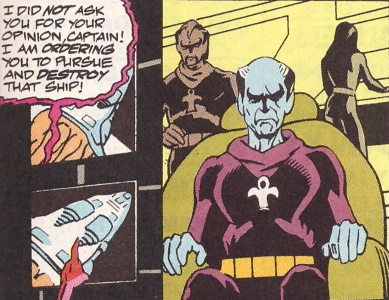
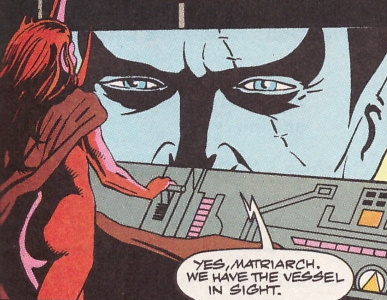
An adult male Sarkan who was the commander of a Universal Church of Truth battle cruiser. Aside from the fact that he had a scar across his left eye and was one of the Sarkans who lacked the three bone ridges on his skull, no personal details about him have ever been revealed, including his name and the name of the UCT starship he commanded. However, the fact that he had been given command of such a starship suggests that he was considered to be a loyal member of the UCT.
In 3018 A.D., Malevolence, the recently-chosen Matriarch of the UCT, discovered that Replica, a Skrull girl who had become the playmate of the Protege, was trying to covertly leave the planet Homeworld in a small, one-person spacecraft. Seeing an opportunity to kill someone she viewed as a rival for control over the Protege, Malevolence contacted the captain and ordered him to pursue and destroy that starship. When the captain apparently had some reservations about those orders, Malevolence told him that she had not asked him for his opinion, she was ordering him to pursue and destroy that ship. As a loyal Universalite, the captain replied,"Yes, Matriarch. We have the vessel in sight." Malevolence then ordered him to shoot it down before ending the audio-visual communications link.
Seconds later, on Homeworld, Malevolence was confronted by the Protege who somehow knew what she had done. Malevolence tried to justify her actions by claiming that Replica had run away from him, an idea that angered the Protege so much that he struck her. However, upon discovering that Replica really was running away from him, the Protege, although hurt and saddened by Replica's leaving, ordered Malevolence to call the battle cruiser back and let Replica go.
Malevolence either disobeyed the Protege's order or delayed carrying it out.
However it happened, the UCT battle cruiser continued its pursuit of Replica's tiny shuttle and eventually began
firing on it. Unfortunately for them, Replica's course caused her shuttle to nearly collide with Firelord, the
current Protector of the Universe. Seeing that the shuttle was being pursued and fired upon by a UCT battle
cruiser and knowing how evil the UCT was, Firelord chose to intervene by growing to enormous size and ordering
the Church ship to cease its pursuit. When one of his crew asked what they were supposed to do now, the captain
replied, "Blast him!" As the UCT battle cruiser then began firing on him instead, Firelord described
their choice as being very stupid and struck the starship with his also-enlarged staff which was ablaze with
cosmic flames.
Since it has never been revealed if that UCT battle cruiser was destroyed or merely disabled by the blow, the status of the captain and his crew is uncertain.
--Guardians of the Galaxy Annual I#2/2 (GOTG Annual I#2/2, GOTG Annual I#2/1 - BTS)
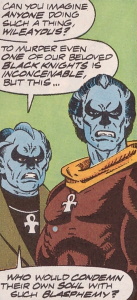
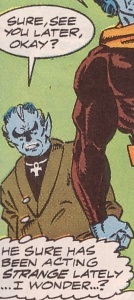
An adult male Sarkan who lived on Sarka and, like most of the population, was a loyal follower of the Universal Church of Truth that ruled his world. The fact that Carinthus wore a suit instead of robes suggests that he was a layperson and not a member of the UCT organization itself. His suit made him look like a businessman, but what his business may have been was not revealed.
Carinthus was part of that segment of the Sarkan population who had three flesh-covered bone ridges on his skull. Like many Sarkans, Carinthus had no hair in the frontal region of his scalp, but the fact that he also seemed to have less hair in his mid-scalp region could be indicative of a receding hairline that may have been due to age. That lack of hair made his cranial ridges seem to be more prominent than those on the head of his friend Wileaydus, but they were actually just more visible because they were less hidden by hair.
Carinthus and Wileaydus lived in the same city on Sarka. That city's name was never revealed but it may have been (and probably was) the city in which the Grand Inquisitor had his headquarters, making it the capital city of Sarka. Although Carinthus and Wileaydus were apparently friends, and possibly even close friends, Carinthus was clearly unaware of the other's true, heretical beliefs.
One morning, as the two friends were walking together through their city, they paused to watch a local newscast on a television screen set up for public viewing. After watching a report about how two more of the Knights of Truth, their world's beloved planetary protectors, had been found murdered that morning, presumably by the serial killer known as the Flaming Demon, Carinthus remarked, "Can you imagine anyone doing such a thing, Wileaydus? To murder even one of our beloved Black Knights is inconceivable, but this...Who would condemn their soul with such blasphemy?" Wileaydus replied that only a madman or a demon would do so, then excused himself, saying that he had to return to his work. As Wileaydus walked away, Carinthus called after him, saying, "Sure, see you later, okay?"
As he watched Wileaydus walk away without answering, Carinthus thought to himself that his friend "sure (had) been acting strange lately" and began to wonder why.
Note: Carinthus has the distinction of being one of the only two Sarkans who have ever been named. He's also one of the only eight Sarkans who have ever had any dialogue.
--Guardians of the Galaxy I#12
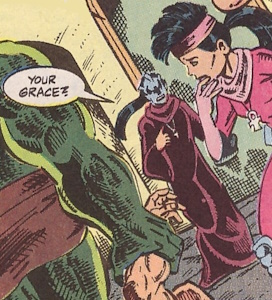
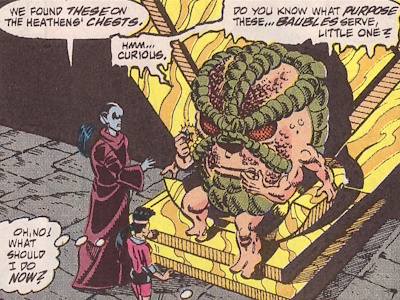
An adult Sarkan who was apparently an aide to the Grand Inquisitor who ruled Sarka on behalf of the Universal Church of Truth. Like most of the Sarkan population, this individual was a loyal follower of the Universal Church of Truth that ruled their world. The fact that he or she wore robes indicated that they were a member of the UCT organization itself, but whether or not they were part of the clergy has not been revealed. However, he or she weas definitely not one of the UCT's Black Knights.
This aide's name was never revealed and neither was the actual name of the position he or she held within the UCT. Additionally, his or her gender wasn't revealed in the only two panels in which he or she appeared. The fact that he or she had long hair that extended well below the shoulders in the back suggests that they were female, but the obscuring nature of the robes he or she wore makes it impossible to determine if he or she had any secondary sex characteristics on the upper anterior region of the torso (i.e., breasts) that would conclusively establish he or she gender. Aside from that, this aide had the pale blue skin, black facial markings and pointed ears possessed by most Sarkans, and the three flesh-covered cranial ridges possessed by many (but not all) Sarkans.
This aide may have been one of the several dozen people who were present in the large chamber in which the alien Guardians of the Galaxy had an audience with the Grand Inquisitor, but, if he or she were there, it isn't possible to locate him or her within the crowd and he or she definitely was not among those who engaged the Guardians in battle.
This aide did not make his or her presence known until after three of the five Guardians had been rendered unconscious and the other two had fled. After gathering the star-shaped badges that the three fallen Guardians had worn on their chests, this aide approached the Grand Inquisitor, addressing him as, "Your grace." The aide then showed the items that they had collected to the Grand Inquisitor, stating, "We found these on the heathens' chests." The Grand Inquisitor found them to be curious and asked Replica, a Universalite who had been associating with the heathens, if she knew what purpose these "baubles" served. Knowing that the Grand Inquisitor could use the stars to find the two Guardians who had escaped if he knew that they were communicators, Replica lied and said that she believed that they were purely ornamental.
What happened to this aide afterwards has not been revealed. The fact that Replica was later shown to have all three stars in her possession when she returned them to the captive Guardians could indicate that Replica had obtained them from the aide and may have used shape-shifting trickery or force in doing so, but this is only speculation.
--Guardians of the Galaxy I#14
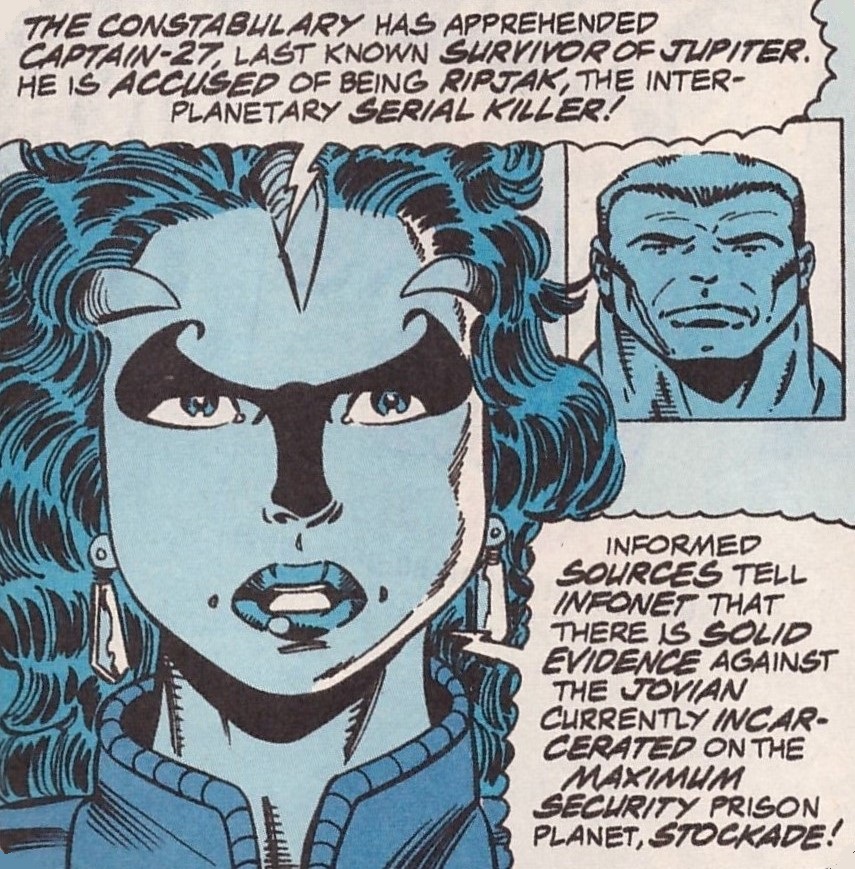

Two adult Sarkans who were employed by Infonet, an intergalactic news service, to report the news. Neither of the newscasters were named but one was female and the other one was male. Both newscasters had the pale blue skin and black facial markings possessed by all other Sarkans, but there were some interesting differences between them. The female, whose gender was established by her long hair and the dark blue lipstick she wore, had the three flesh-covered cranial ridges possessed by many (but not all) Sarkans but her ears could not be seen. In contrast, the male newscaster not only lacked any flesh-covered cranial ridges, he also had ears that were rounded instead of pointed, making him the only Sarkan known to have such ears.
Interestingly, neither newscaster was shown wearing the "ankh" pendant that members of the Universal Church of Truth wore as a symbol that they were true believers. This could indicate that the studio from which they made their intergalactic broadcasts was not located on Sarka.
(Guardians of the Galaxy I#51 (fb)) - At some point in the year 3019 A.D. (Earth date),
the female Infonet reporter broadcast the following news item:
"The Constabulary has apprehended Charlie-27, last known survivor of Jupiter. He
is accused of being Ripjak, the interplanetary serial killer! Informed sources tell Infonet that there
is solid evidence against the Jovian currently incarcerated on the maximum security prison planet,
Stockade!"
(Guardians of the Galaxy I#51 (fb) - BTS) - The Guardians of the Galaxy learned of the whereabouts of their missing comrade by watching that Infonet broadcast while aboard their starship, the Icarus, and then headed to Earth to recruit some allies powerful enough to be able to help them break Charlie-27 out of Stockade.
(Guardians of the Galaxy I#51 - BTS) - While the Guardians were on Earth talking to Molly Fitzgerald (Shamrock) about their missing comrade, Nikki revealed that they had found out the Jovian's current whereabouts like everyone else had -- "by watching an Infonet broadcast from the planet Sarka!"
(Guardians of the Galaxy I#56) - Sometime later that year, the male Infonet reporter
broadcast the following news item:
"This is a special bulletin from Infonet, your intergalactic news source. Our
tele-cameras have confirmed the depopulation of the planet Aran IV! This reprehensible genocidal act
is unquestionably the work of the infamous Ripjak, who was reported to be in custody on Stockade, the
prison planet!"
The Infonet reporter then began speaking to an interviewee who appeared
on a television screen behind him, saying:
"With us now is the Chief of the Constabulary and head of operations at Stockade...Chief,
the public has a right to know the truth -- Will you confirm the reports that the last surviving Jovian,
Captain-27, is no longer your prime suspect and has been released?" The Chief replied to that question
by saying that he had no comment, except to say that if someone wanted information on Ripjak, they should
contact Captain-27's associates, the Guardians of the Galaxy!
Aboard the Icarus, Talon, Charlie-27 and Nikki were watching that broadcast and realized that the Chief, who held a grudge against them for the way they had humiliated him when they freed the innocent Charlie-27 from Stockade, was falsely implicating them in Ripjak's crimes in front of trillions of Infonet viewers.
Soon afterwards, aboard his own starship thousands of parsecs away,
Ripjak watched the end of that broadcast, which concluded with the male newscaster saying:
"...and so, galactic residents continue to live in fear of the malignant mass
murderer, Ripjak!"
At that point, Ripjak ordered his ship's computer to turn the audio portion of the broadcast off, and he mused aloud to himself about the "ignorant fools" and how "their perception of (his) true objective (was) absurdly skewed!"
--Guardians of the Galaxy I#51 (fb), Guardians of the Galaxy I#56
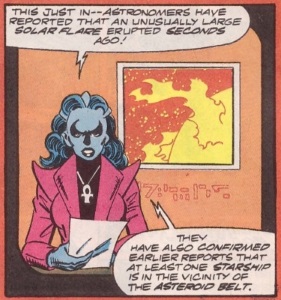

An adult female Sarkan who lived on Sarka and, like most of the population, seemed to be a loyal follower of the Universal Church of Truth that ruled her world. At least, she did wear the "ankh" pendant that Universalites wore as a symbol that they were true believers. However, the fact that she didn't wear a purple robe indicates that she was a layperson and not a member of the UCT organization itself. Her name has never been revealed.
This newscaster had the pale blue skin, black facial markings and pointed ears possessed by most Sarkans, and the three flesh-covered cranial ridges possessed by many (but not all) Sarkans. While her long hair and the dark blue lipstick that she wore strongly indicated that she was a woman, she was also the only Sarkan yet seen to be depicted as having a widening of the upper anterior region of her torso that indicated the presence of secondary sex characteristics (i.e., female breasts).
Although her news reports were shown on television screens in the city where Carinthus and Wileaydus lived, presumed to be the capital city of their planet, the location from which she broadcast those reports was not revealed and may not even have been in the same city.
The only news report that this newscaster was shown reading went as follows:
"This just in--Astronomers have reported that an unusually large solar flare erupted seconds ago! They have also confirmed earlier reports that at least one starship is in the vicinity of the asteroid belt."
"Whether these incidents are connected -- or whether this starship is bringing more Knights of Truth as reinforcements remains to be seen."
"And speaking of the Holy Knights...two more of our beloved planetary
protectors were found murdered this morning.
Police believe that these murders were committed by the same
serial killer responsible for 42 similar homicides -- the Flaming Demon!"
After watching this broadcast, Wileaydus was inspired to get back to his work and used some scanning technology he possessed to confirm the presence of a starship and super-powered beings in the asteroid belt. This led him to conclude, wrongly, that the newscaster's speculation that the starship was bringing super-powered Knights to Sarka was accurate.
Note: Although not established in-story, I have chosen to refer to her as a "local" newscaster because the only news items on which she reported were relevant only to Sarka, and not to the wider universe. This is an assumption on my part and may be incorrect, but I'm comfortable with it.
--Guardians of the Galaxy I#12
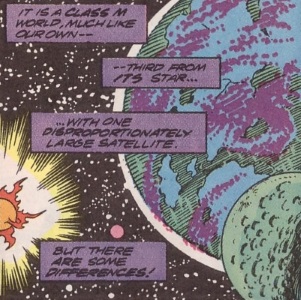
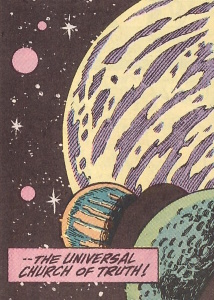
The third planet from the sun in the Tilnast star system, Sarka was a "Class M" world that was much like Earth, with 74% of its surface being covered by water. Although its gravity was 10% greater than that of Earth, its environment and its atmosphere were close enough to those of Earth that all of the Guardians of the Galaxy could exist there without any problems.
Sarka was the homeworld of a race of blue-skinned humanoids who called themselves Sarkans. At one time, the Sarkans were governed by theocratic monarchies, implying the existence of a number of separate nation-states, but nothing has been revealed about how many such nations existed or what their names were. Additionally, nothing has been revealed about the religions upon which these theocracies were based, except for the fact that they were all outlawed once the Universal Church of Truth became the accepted planetary religion/government, with a Grand Inquisitor from the UCT serving as their royal ruler.
Very little data about Sarka has been revealed. The information that has not been made available includes the number of continents and oceans that existed on the planet and their names, the number of countries that existed and their names, and the number of cities that existed and their names. During their brief time on Sarka, five members of the Guardians of the Galaxy stayed within what was presumably now the capital city of the planet for their entire visit and noticed little except that the architectural styles of the city's building were oddly reminiscent of New York City in Earth's late 20th century (see note).
Although the Sarkans (or maybe just the UCT) had access to spacecraft, no aircraft were seen flying in the skies. Those few road vehicles that were seen had no visible wheels, suggesting that they were all hover cars instead of automobiles.
Sarka is known to have had at least two moons, both of which were depicted as orbiting the planet VERY closely. While the larger moon orbited further out from Sarka and its grey surface was covered with craters, the smaller moon orbited more closely and its surface was mostly green but with orange horizontal bands of varying widths across it, possibly indicating that it had an atmosphere. There may have been two other moons that orbited at far greater distances, but those those spheres could actually have been nearby planets instead.
Although the U.S.S. Captain America II was stated to have been in dry dock undergoing repairs while in orbit around Sarka, there didn't seem to be any actual orbital facilities involved, only small repair craft flying around the starship.
--Guardians of the Galaxy I#12-14
Notes: Aside from the basic information about Sarka that was invented for the
quarter-page entry on the Sarks that appeared in The Official Handbook of the Marvel Universe I#9, the
two images included in this sub-profile contain most of the new data provided in Guardians of the Galaxy
I#12-14, and that data is weird and inconsistent in several ways:
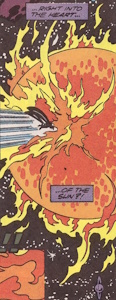
The planetary system which included the planet Sarka. Aside from the fact that it was located somewhere within the Milky Way galaxy, very little information has been revealed about this star system.
--Guardians of the Galaxy I#12-14 (mentioned in GOTG I#15)
Notes: According to several online sources (which can be found here, and here), in the real world, the term "star system" (or "stellar system") is (or should be) used exclusively in reference to a small number of stars that orbit each other because they are bound by gravitational attraction, and they are not to be (or should not be) confused with planetary systems, which include planets and similar non-stellar bodies. However, in science fiction stories, the term "star system" is almost always used to refer to planetary systems that are in orbit around a star or group of stars. The Star Trek Universe, the Star Wars Universe, and the Marvel Comics Universe are among those continuities which use the later definition.
In GOTG I#12, the first three panels on page 15 show Starhawk flying right into the heart of the local sun, and nine (or ten) spherical objects can be clearly seen in the backgrounds of those panels. While two of them might be Sarka and its (single?) moon, that leaves the seven (or eight) other objects without any explanation for their presence. Sadly, the practice of drawing lots of spherical objects in the backgrounds of scenes set in space seems to a long-standing one, even though it doesn't often (or, you know, EVER) really make any sense.
images: (without ads)
The Official Handbook of the Marvel Universe I#9, page 31, panel 3 (main image - Sark)
Guardians of the Galaxy I#12, page 16, panel 1 (crowd watching newscast)
Guardians of the Galaxy I#13, page 9, panel 6 (crowd looking up in the sky)
Guardians of the Galaxy Annual I#2, page 40, panel 4 (UCT captain)
page 40, panel 3 (UCT captain close-up)
Guardians of the Galaxy I#12, page 16, panel 2 (Carinthus talking with Wileaydus)
page 16, panel 3 (Carinthus watching Wileaydus walk away)
Guardians of the Galaxy I#14, page 12, panel 4 (aide with Replica)
page 12, panel 5 (aide with Grand Inquisitor)
Guardians of the Galaxy I#51, page 8, panel 4 (female Infonet newscaster)
Guardians of the Galaxy I#56, page 5, panel 1 (male Infonet newscaster)
Guardians of the Galaxy I#12, page 15, panel 6 (local newscaster)
page 16, panel 1 (local newscaster close-up)
Guardians of the Galaxy I#12, page 15, panel 5 (Sarka and its single moon)
Guardians of the Galaxy I#13, page 1, panel 4 (Sarka and its two moons)
Guardians of the Galaxy I#12, page 15, panel 3 (Sarka's sun)
Appearances: (excluding those issues in which only the Spirit of Vengeance appears)
Guardians of the Galaxy I#12 (May, 1991) - Jim Valentino! (procrastinator), Steve Montano! (delineator), Craig
Anderson! (naysayer)
Guardians of the Galaxy I#13 (June, 1991) - Steve Montano (inked it on a dare!), Craig Anderson (edited it
with care!), Jim Valentino (hasn't got a prayer!)
Guardians of the Galaxy I#14 (July, 1991) - Jim Valentino (manual labor), Steve Montano (repromaster), Craig
Anderson (slave driver)
Guardians of the Galaxy Annual I#2/2 (1992) - Jim Valentino (story), Kirkowood Studios (pencils), Bob Almond
(inks), Craig Anderson (editor)
Guardians of the Galaxy I#51 (August, 1994) - Michael Gallagher (ploh tandscript), Kevin West (burr achedowns),
Steve Montano (finnish dart), Craig Anderson (edih torr)
Guardians of the Galaxy I#56 (January, 1995) - Michael "Write Tackle" Gallagher (script), Kevin "Point Guard"
West (pencils), Steve "Brush Back" Montano (inks), Craig "Coach" Anderson (editor)
First Posted: 07/05/2024
Last updated: 07/05/2024
Any Additions/Corrections? please let me know.
Non-Marvel Copyright info
All other characters mentioned or pictured are ™ and © 1941-2099 Marvel Characters, Inc. All Rights
Reserved. If you like this stuff, you should check out the real thing!
Please visit The Marvel Official Site at:
http://www.marvel.com
Special Thanks to http://www.g-mart.com/ for hosting the Appendix, Master List, etc.!